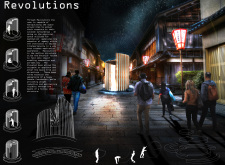5 key facts about this project
The design characterizes itself as a spiral structure, inviting users to immerse themselves in its dynamic form. This configuration not only creates a visually pleasing aesthetic but also promotes fluid movement, inviting individuals to enter from various angles and experience the space in a personal manner. This emphasis on user agency is a core facet of the project, suggesting that architecture can enhance well-being by allowing occupants to continuously adjust their spatial experience.
One of the notable aspects of "Revolutions" is its material palette, which plays a vital role in defining both the functionality and aesthetic clarity of the design. The use of glass allows for transparency, facilitating a seamless integration between the interior space and the bustling urban surroundings. This choice fosters a sense of openness while simultaneously allowing natural light to penetrate deep into the structure, highlighting the interplay between light and shadow that evolves throughout the day. The structural integrity is achieved through a steel framework that supports the complexity of the design, ensuring durability while maintaining a lightweight appearance.
Wood is also thoughtfully incorporated, offering warmth and a tactile contrast to the sleek glass and steel elements. This interplay of materials reflects the project's commitment to blending contemporary aesthetics with local architectural traditions, creating a harmonious balance that resonates with the community. Furthermore, LED lighting is integrated strategically to enhance the ambiance after dusk, adding a layer of versatility to the project's functionality.
The unique design approach of "Revolutions" lies in its ability to accommodate a multitude of activities and user experiences. The scheme allows for informal gatherings, individual reflection, and spontaneous interactions, transforming the structure into a catalyst for community connection. By providing spaces that cater to different forms of engagement, the architecture encourages a relationship between users and their environment that thrives on both connectivity and solitude.
"The Revolutions" elevates the understanding of public space in an urban context by demonstrating how thoughtfully designed architecture can challenge conventional interactions. As users manipulate their physical surroundings in pursuit of a meditative state, the project invites them to appreciate the nuances of space and time, offering an environment conducive to both reflection and engagement. This duality stands as a testament to the evolving nature of architecture that not only serves practical needs but also enriches the human experience.
For those interested in exploring the intricate details of this project further, including architectural plans, sections, and various design elements, a closer examination of the project presentation will provide valuable insights. Delving into these aspects can enhance the understanding of the architectural ideas that underpin "Revolutions," revealing the thoughtful considerations that contribute to its distinctive character and purpose within the urban landscape.























